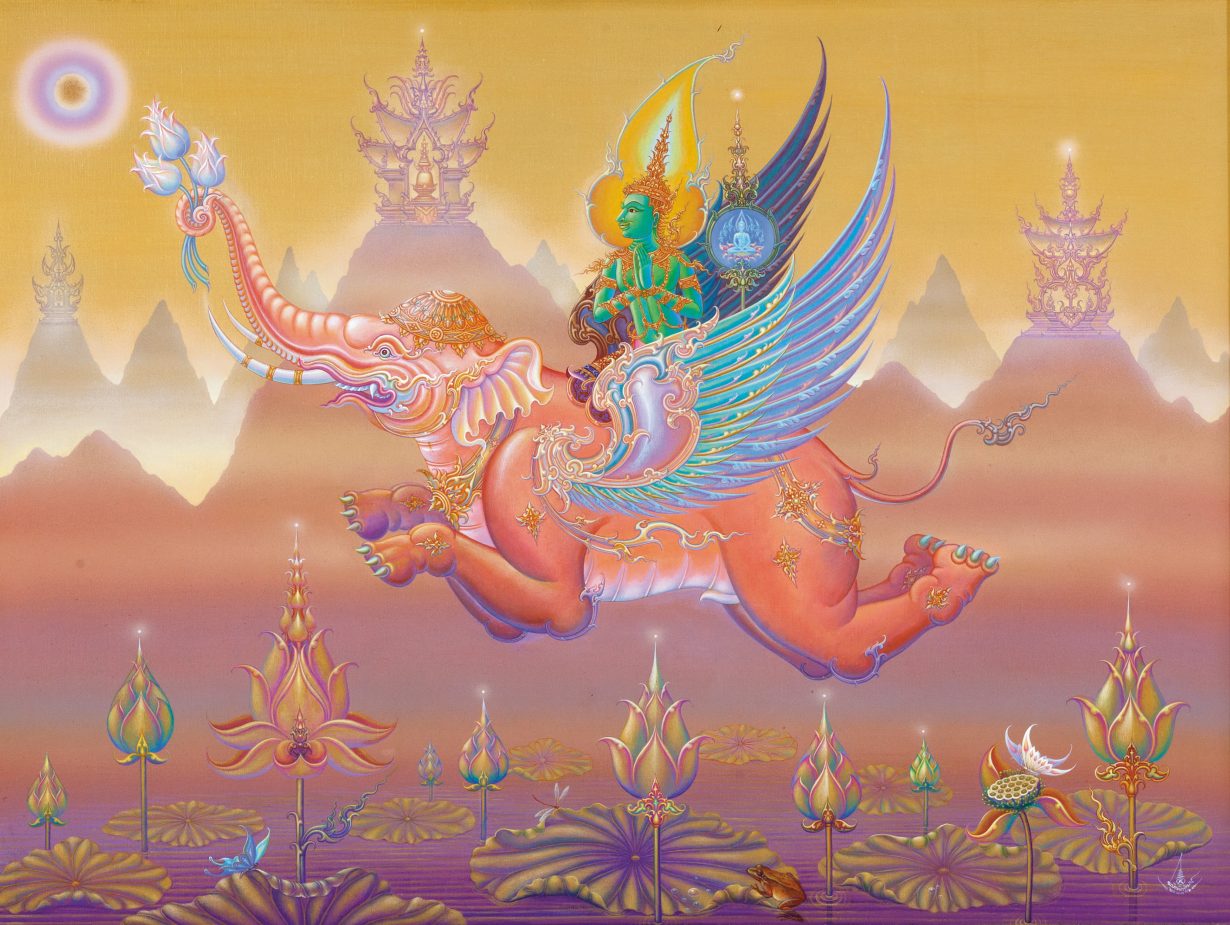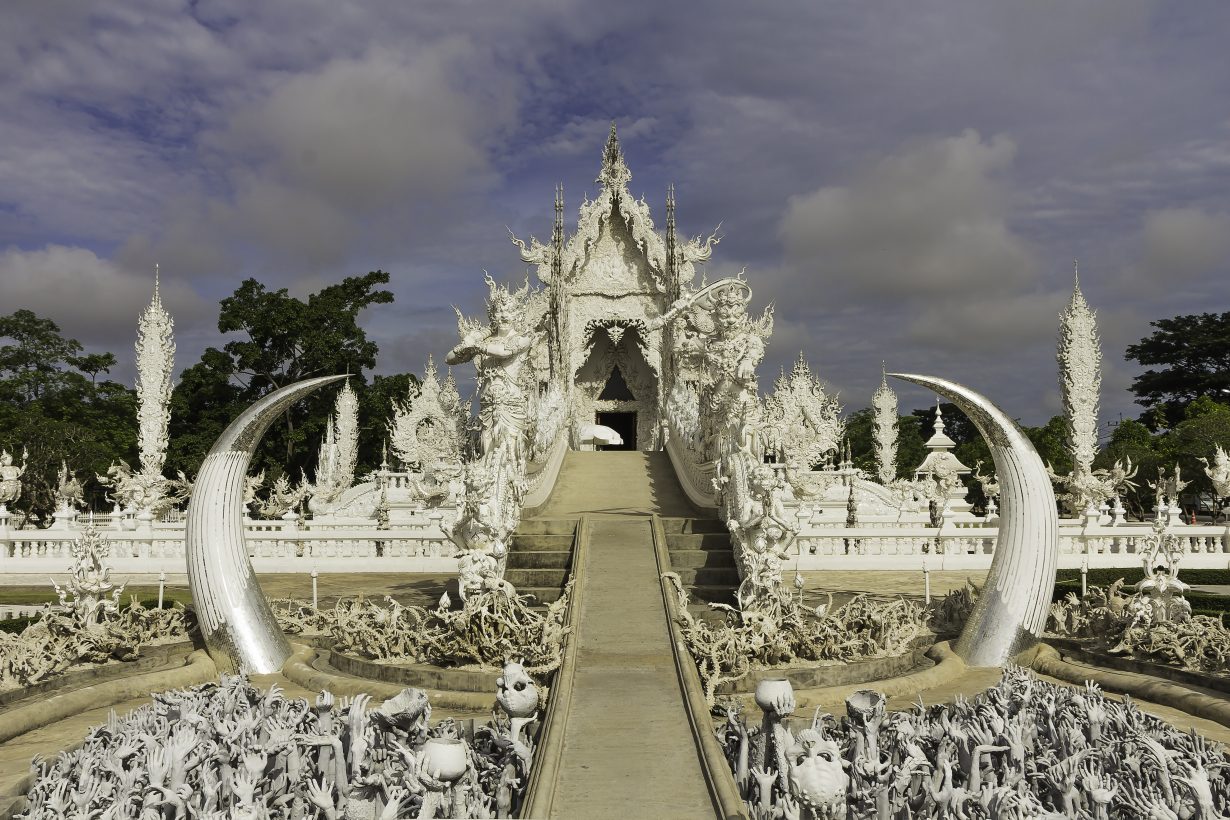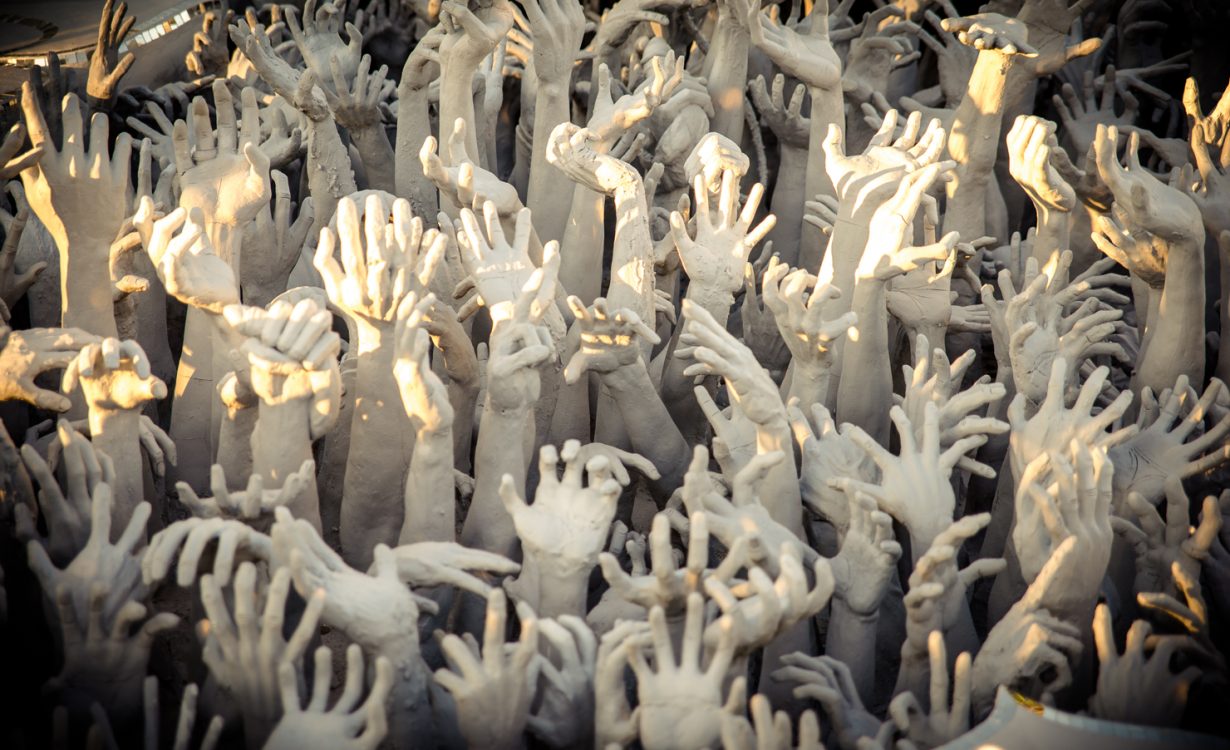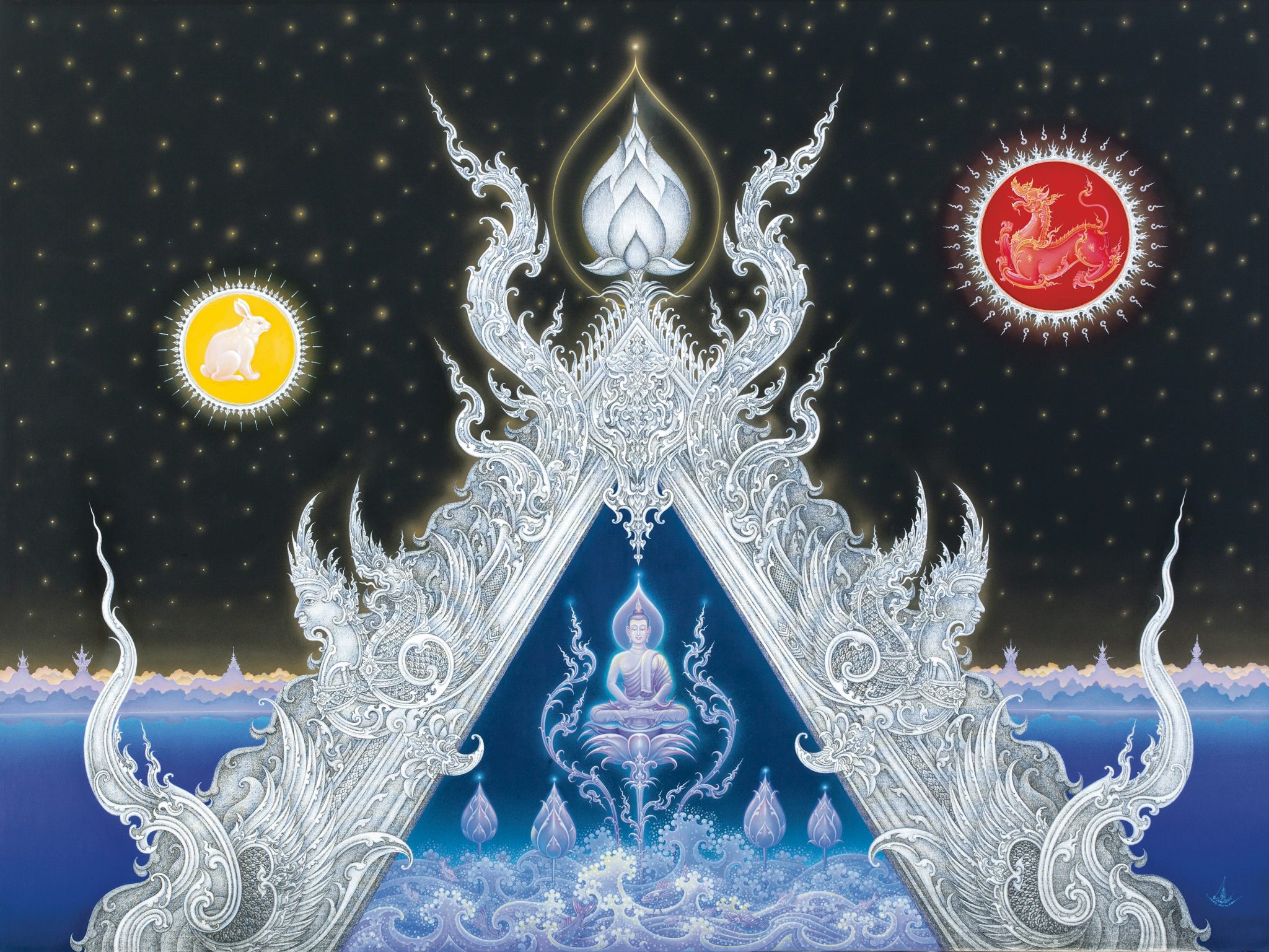In the runup to Thailand Biennale in Chiang Rai, Max Crosbie-Jones pauses to consider the origins of one native son’s staggering cultural power
Here’s a surefire prediction for the winter months: Thailand’s northernmost province, Chiang Rai, will host a sprawling showcase of contemporary art. And here’s another: visitors to that showcase (the third Thailand Biennale) will, at some point during their trip, find themselves staring at the pious and phantasmagoric visions of one of the country’s brashest National Artists (a title awarded annually by Thailand’s culture commission).
The off-piste surprises that await art lovers include polished paintings of the Buddha, devas (celestials) and mythical fish levitating in aqueous skies speckled with rococo clouds; a golden city clocktower ornamented with flaming lai kranok motifs; murals of the Traiphum (Thai Buddhist cosmology’s three worlds) featuring cameos from The Matrix’s Neo and from Hello Kitty; and, most famously, a baroque temple (the sprawling complex of which is one of the biennale’s host venues) that appears to have been dusted with icing sugar. In short, while the Thailand Biennale wants visitors to mull over a range of political and historiographic questions pertinent to the ethnically diverse city of Chiang Rai (and the mountainous region surrounding it), some are also likely to come away asking: how did one local artist accrue so much power within it?
For over two decades, the ethereal Theravāda Buddhist baubles and confections of Chalermchai Kositpipat – at once a celebrity known for his loose tongue and a master of delicate line and form – have been one of the province’s biggest tourist draws. But his distinctive oeuvre is also of broader significance: tapping clubby networks of corporate patronage, reverentially riffing on temple mural traditions, ostensibly divorced from worldly materialism yet exceedingly bankable, gaudy yet seductive, it arguably ranks as the ne plus ultra of Thailand’s so-called Neotraditional art movement. Not least because Kositpipat’s coming to prominence during the late 1970s is indivisible from the milestones that mark this parochial, arguably retrograde school of art’s emergence.

Born in Chiang Rai in 1955, he first gained public recognition for his tempera paintings of temple scenes, most humbly depicting worshippers praying or chatting. While hardly groundbreaking, the linear perspective and technical virtuosity of one painting in particular, A View of Thai Life (1977) – featuring women clad in paasin (wraparound silk dresses) drinking tea or chewing betel nut – was deemed inventive enough to bag him first prize in a fledgling art competition.
Launched in 1974 by one of the country’s top banks, the Bualuang Painting competition (now in its 44th edition) has been credited with spurring the outpouring of establishment-friendly nostalgia – archaic Siamese motifs rooted in Buddhist and Brahmin beliefs, often filtered through a surrealist sensibility that owes more to the mythic magic of the Thai spirit world than the automatist’s mind – with which Kositpipat is today synonymous (he’s now on the judging committee). ‘Prior to this period,’ writes Apinan Poshyananda in Modern Art in Thailand: Nineteenth and Twentieth Centuries (1992), ‘traditional Thai painting, with its emphasis on iconography, was regarded as old-fashioned… But by offering this category in the contest, the Bangkok Bank stimulated the blossoming of new works in the traditional Thai style. Indeed, the policy of the bank was so effective that a few years later a Department of Thai Art opened at Silpakorn University.’
One of this department’s first two graduates, Kositpipat emerged, in the decade after receiving this award, as the personification of a shrewd new type of unofficial artist –civil servant. Since its inception during the 1940s, Bangkok’s Silpakorn University – an integral player in the country’s nation-building and projection of worldliness – had churned out artists drilled in the modernisms of the West, especially Italian academic fine-art, to the detriment of vernacular traditions. But Kositpipat and his ilk sought to resuscitate the skills of the country’s khru chang (artisans), namely the temple painters sidelined amid the country’s modernist fervour.
In commercial terms, they succeeded. Between 1984 and 1988, he, alongside another graduate from the department, Panya Vijinthanasarn, dedicated himself to decorating the ubosot (ordination hall) at Wat Buddhapadipa in leafy southwest London – a Thai government-backed project often held up as the movement’s defining achievement (one they apparently worked on for free). Amid its afterglow, and the burgeoning art competitions back at home, they and other neotraditional artists went on to enjoy market success and institutional stature. Their works were snapped up by the nouveau riche, or mounted in the headquarters of banks and in the lobbies of gaudy hotels.

According to some academics, this revivalism dovetailed neatly, and advantageously, with a renewed neoconservatism and demonstrative monarchism among a certain sector of society (the student massacre of 6 October 1976 had halted a leftist social awakening and ‘art for life’ movement). ‘What the new bourgeoisie needed, above all,’ writes David Teh in Thai Art: Currencies of the Contemporary (2017), ‘were ways to demonstrate its Thainess (kwampenthai) in the eyes of an elite increasingly given to pretentious displays of loyalty to the throne… Buddhist and pseudo-Buddhist symbolism offered a fittingly empty vessel, into which could be poured this or that mythic notion of kwampenthai. “Traditional” motifs mushroomed, in inverse proportion to the new patrons’ actual connection to this aesthetic heritage.’
This reading exposes a crack in Kositpipat’s larger-than-life persona and practice. In the eyes of many Thais, he’s an iconoclast – a gadfly known for being loud and unfiltered, whether he’s helming an American Idol-style art talent TV show, hogging the microphone at an opening or venting about the transfer of Chiang Rai’s governor in the runup to the biennale. Meanwhile, Wat Rong Khun, his stucco-accented ‘White Temple’ on the outskirts of the city, is often held up as the audacious masterpiece of an avant-gardist who has forever shaken up the stagnant discipline of Buddhist art.

Behind these contrarian facades, however, lurks a social conservative, a man fixated on ossifying the country’s three pillars – Buddhism, nation and monarchy – not interrogating or moving past them. For all its breaks with tradition (its shimmering whiteness and mirrored surfaces, for starters), the White Temple is dedicated to the most orthodox Thai subject of all: the reign of a monarch, the late King Bhumibol. Moreover, despite his use of acrylic rather than tempera paints, its murals – which juxtapose celestials with images of the flaming World Trade Center and Batman – are arguably in keeping with Buddhist temple painting, not contrary to it. According to Andrew J. West in Thai Neotraditional Art (2015), Thai murals have long paired ‘extramundane religious material’ with ‘contemporaneous elements reflecting the society and culture of the general population as manifested at the moment they were composed’. This is especially the case in the temples of the Kingdom’s far north, the Lanna region.
Now sixty-eight, and semiretired, Kositpipat’s singularity – and eminence in the Thai painter pantheon – may simply boil down to his replacing the shock of the new with the shock of the old with added theatricality and tenacity, more compositional harmony and clarity of vision, more pizzazz, than his peers (to say nothing of his hucksterish, devil-may-care attitude: ‘I’m fucking perfect. I’m good at art, management, PR and presentations. There is no defect in me,’ he once said).
Anecdotally at least, an hour or so spent exploring his masterwork confirms this. Visitors, before or after relieving themselves in the complex’s golden restrooms, or viewing his sketches and paintings, enjoy an experiential form of Buddhist exegesis: to reach the White Temple’s mural-lined ubosot, we must reenact the cyclic journey of samsāra by strolling across a pit of writhing arms (ie, Hell), then crossing a dazzling bridge representing rebirth. While neotraditionalist canvases that juxtapose the extramundane with quotidian ordinariness are ten a penny (something that Thailand Biennale visitors may also discover – Chiang Rai is something of a stronghold), Kositpipat set himself and his faith apart by going 3D, transposing the devotional cosmologies of his didactic paintings into a wacky, yet workable, architectural blueprint. Moreover, by realising it he has elevated the movement’s schtick – contemporary reworks of noble truths and state-sanctioned vestiges of the past – to yet another plane of existence: the realm of mass tourism.
